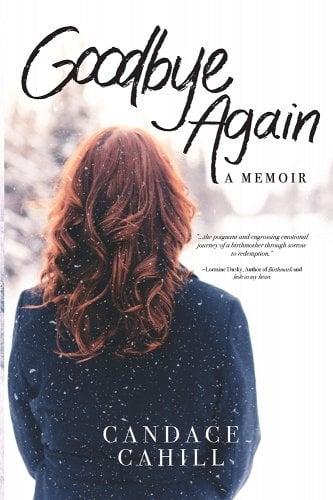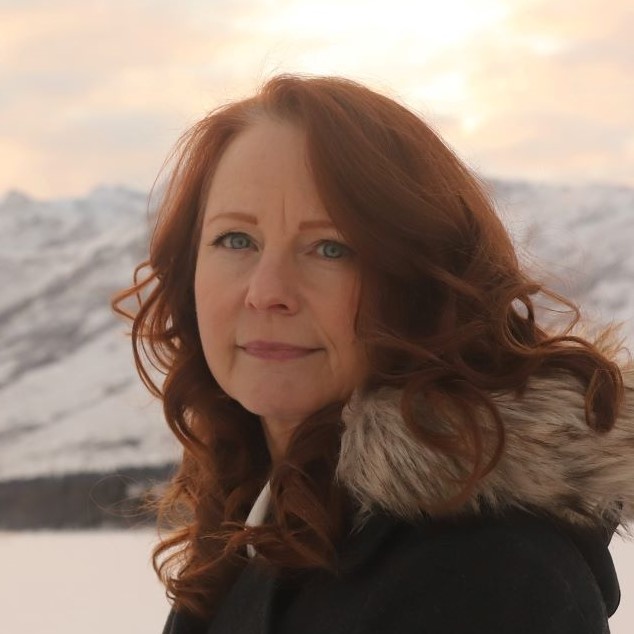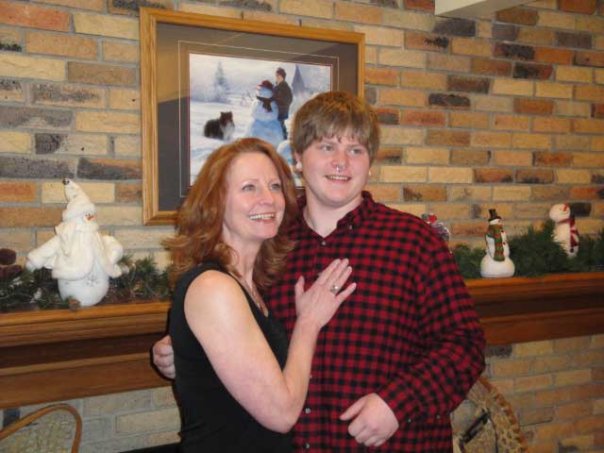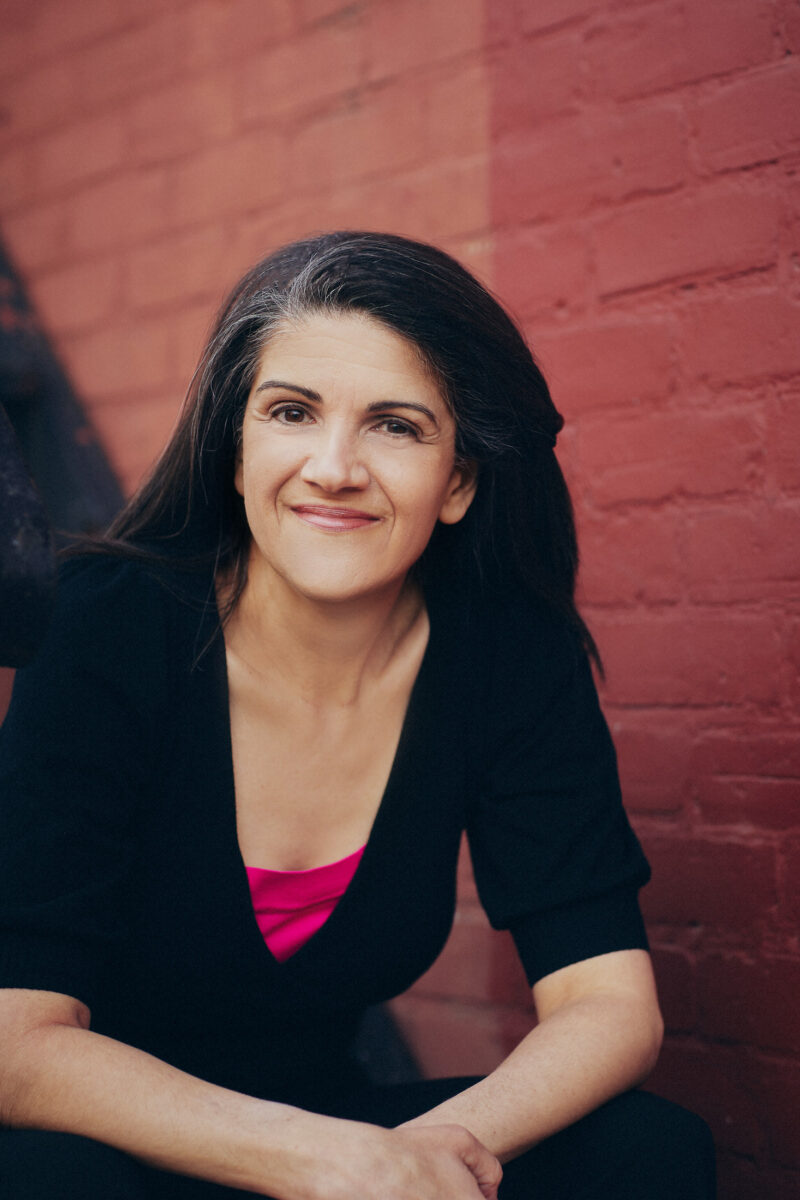Interview by Michèle Dawson Haber
 Candace Cahill’s debut memoir, Goodbye Again: A Memoir is the story of losing her son Michael twice, first to adoption and the second time when he died at age 23. The reader follows Candace from the moment she makes the decision to give birth to her baby, to her tortuous decision to relinquish him to adoption, through the subsequent years of doubt and yearning, to their reunion, and finally, to his heart-wrenching, untimely death.
Candace Cahill’s debut memoir, Goodbye Again: A Memoir is the story of losing her son Michael twice, first to adoption and the second time when he died at age 23. The reader follows Candace from the moment she makes the decision to give birth to her baby, to her tortuous decision to relinquish him to adoption, through the subsequent years of doubt and yearning, to their reunion, and finally, to his heart-wrenching, untimely death.
This intimate story of child relinquishment and child loss is a sensitive and intelligent exploration of motherhood and forgiveness. Goodbye Again: A Memoir, which debuted November 10, 2022, with Legacy Book Press LLC, is a welcome addition to the canon of adoption stories.
Candace and I connected just a few weeks after her book tour wrapped up to talk about the craft of writing, identity, and the urgent need to change public perceptions and attitudes about adoption. What follows are the highlights of our conversation.
Michèle Dawson Haber: Congratulations, Candace, on getting your memoir into the world! Goodbye Again is such an engrossing read. I was compelled to turn to the next page, and then the next—that’s how riveted I was by the emotional intensity of the narrative.
We usually try in Hippocampus interviews to avoid spoilers, but in the case of your memoir, the narrative arc is stated up front on the book jacket and in the plot synopses. The reader knows before she even opens the book that your son will die. What your book so aptly demonstrates is that memoirs don’t need bombshell reveals to hold the reader’s attention. Can you talk about the considerations that go into deciding how best to unfold a story like yours for the reader?
Candace Cahill: Thank you—my publisher had a hard time with my desire to put so much on the jacket, and she actually cut a lot out, but I wanted people to know the whole story upfront. I believed that if I did a good enough job with the writing, readers would stay engrossed even though they knew the ending. I thought carefully about where I ended chapters—I wanted the feel of a cliff hanger for each—but needed to give just enough information so readers would know what happened but keep them hanging on to find out more. I wanted readers to feel as if I was sitting next to them telling the story. It was about finding the right balance between exposition and scene.
In terms of the narrative arc, I originally opened the book with the scene when I hear Michael has died, and then I interspersed my pregnancy and his childhood. It worked, but not as well as when I arranged the events chronologically. I’m much happier with this structure; it feels more intuitive.

Candace Cahill
MDH: Your story about one birth mother’s—let’s use the preferred, less clinical language—one first mother’s experience of adoption from pregnancy, relinquishment, years of no contact, and then reunion, is an important contribution to the discourse on the impact of adoption. Did you read other memoirs by first mothers before starting yours? What gaps did you identify in other books that you believed you could fill by writing Goodbye Again?
CC: That is a really good question. Narratives from the point of view of a member of the first family have been, until recently, mostly non-existent. When I was searching for stories like mine, there were so few available. But the decision to write the book had nothing to do with this. My husband Tom and I were on vacation, and I told him my dream would be to write a book one day and he said, “why wait?” So, in sitting down to write it, my only thought was, I’m just writing my story for me, it’s not going to be published. It was only when I got about halfway into it that I realized it should be out there, because it is a story you just don’t hear.
Once I made the decision to write a manuscript-length work, I avoided all memoirs completely. I did this so I wouldn’t unintentionally imitate the structure or ideas of other authors, and also to prevent myself from being distracted from the story I wanted to put on the paper. When I was done with the writing and submitted it to my publisher, I began to gobble up memoirs, because I’m so far behind—I really love the genre.
MDH: There are many who believe that adoption should be abolished altogether. These advocates say that the effort and resources that are put into adoption should be redirected to family preservation.
In Goodbye Again, you make quite clear that the decision to relinquish your son when you became accidentally pregnant at age 21 was the right one for you. Although, early in the book, you have a moment of retrospection where you consider what might have happened had your social worker expressed faith in your ability to learn parenting skills or told you that you had the right to sue your boyfriend for child support.
Where do you position yourself in this debate and what do you hope those looking to abolish adoption in all but the most extreme cases will take away from your story?
CC: That’s a big, big question and I hope my book will be a discussion starter. My story puts me on both sides of that issue. It could be used by an abolitionist, and it could be used by adoption proponents as well. Writing my story has helped me come to see that two things can be true at one time.
I don’t believe that we are ever going to get to a place where adoption isn’t needed at some point. There will be times when the natural parents are incapable, unavailable, pass away, or whatever it may be, and there are no other kin that can step in. But we do need to make much more of an effort at family preservation, or at the very least, we need to quit stealing children’s identities. If adoption is going to take place, adopted people need to maintain their genetic contacts. Even if the family is dangerous, that does not negate the adoptee’s right to know their past. In the US, adoption requires the birth certificate to be changed—the old one is sealed up, and a new, false one is made. And that’s wrong; we can’t be taking away people’s identities. If the adoption laws were changed and we added first parents to the birth certificate, that would be different.
“Writing my story has helped me come to see that two things can be true at one time.” — Candace Cahill
MDH: I think a lot of people are banding together right now to change those laws.
CC: Yes, they are. Efforts are being made at both the state and national levels.
MDH: Identity is a huge issue for adopted kids, but only after reading your book did I consider that a first mother might also undergo an identity crisis. Do you mind telling me what you discovered about your own identity over this period?

Candace and Michael
CC: My biggest struggle was recognizing that I was a mother. That, despite the fact that I relinquished my child, I still was a mother. Before, I didn’t think I deserved to think of myself that way, but it was really Tom’s influence that allowed me to open that door. I’m not a parent—I was never a parent. But I am a mother.
MDH: Step-adoption is a particular interest of mine. Although it’s not given a lot of space in your story, a careful reader notices that you too are an adoptee—a step adoptee. [A child raised by one genetic parent and one stepparent who has legally adopted them.] How do you think the discovery of this fact of your personal history impacted your story? Did you know anything about your first dad?
CC: I didn’t discover that I had a different dad until I was 13. There was an argument between family members going on upstairs, and I figured it out. My initial reaction was one of utter relief. I was overjoyed that the man who had abused me was not my father. I didn’t even care about who the other father was. And that’s how it was for years. I only learned later, in my 20’s, that my mom had divorced and remarried when I was an infant, that my first father agreed to relinquish his parental rights, and that my stepfather adopted me. When I started to look at relinquishing my child, I wasn’t identifying myself as an adoptee. And that’s very sad. Looking back, I know that my young self felt completely abandoned.
Now, since writing the book, that’s a big part of where my regrets come from: regretting that I chose to relinquish my son, knowing what that abandonment could and would feel like, as he grew. That’s been one of the hardest things to accept in myself.
I remember the moment I began to identify as an adopted person happened at a retreat about a year and a half ago. I was sitting in a mixed support group with adoptees, first parents, and adoptive parents. Adoptees were given the first opportunity to talk because historically, they are the ones who never had a voice. As they talked and shared their experiences and emotions, I felt the same feelings as each person who spoke: abandonment, anger, feeling like I missed out on what should have been mine. I walked out of there realizing that I’m not only a first mother, I’m an adoptee too.
MDH: Who did you write this book for? Who do you imagine your ideal reader to be?
CC: I think that my ideal reader is someone who’s never thought very long or hard about adoption. I’ve just completed book launch events, and one of the most impactful interactions I had was with a woman whose sister adopted a child who told me that when the baby was brought home, the whole community came out to welcome the baby and it was an unbelievably beautiful, grand event. As she was telling me this, she was in tears. She said, “I never once thought about the loss of that baby’s first family. Never once.” And that was a profound moment for me. So, for people who have never questioned the “rainbows and unicorns” fairy tale of adoption, this will be a powerful book. And I hope my story will allow people to embrace both sides of the issue.
MDH: Writing a memoir about something as painful as child loss can’t be easy. It’s been nearly ten years since Michael died and, although I know the pain of his loss will never go away, I imagine that the rawness of it has been muted by time. Did the writing of your story bring you back to that time of excruciating grief? What advice for memoirists do you have for those who fear reliving their trauma if they were to write their story? How has the aftermath been?
CC: Yeah, the rawness has definitely subsided, but I had to write in such a way that people could feel what I experienced, and to do that I needed to re-feel it myself. Going back was really hard. Usually, Tom could tell if it had been one of those days when I had to relive hard things, and he gave me the support I needed. I think it’s really important for writers who are going to revisit any traumatic events to make sure they’ve got a safe space to go afterward. There’s another side: having relived it, and then written it down, I have been able to process my grief to a fuller extent than I ever did before. I am a much stronger, more grounded, and balanced person. I can talk about Michael’s loss now without completely losing it.
“I think it’s really important for writers who are going to revisit any traumatic events to make sure they’ve got a safe space to go afterward.” — Candace Cahill
MDH: Can you tell me a bit about your publishing journey? Did you do any writing on this subject before your memoir? Did you go through an agent or direct to the publisher? How long has Goodbye Again taken to get into the world, from inception to publication?
CC: Within a year after my son died, I started writing a blog called “Lost Again,” because I couldn’t talk about it, so writing was an avenue to find release. I blogged for a couple of years but set that to the side. I officially started writing the memoir in the summer of 2019 after Tom’s comment while we were on vacation. Then when COVID hit, I lost my work as a tour guide, and I began to write every day as if it was a job. I shared chapters with my memoir writer’s group every week for nearly a year. In the end, each chapter had gone through the critique process twice, followed by a full beta read. I started querying agents in February 2021, but then got a new job in June and put it aside for the summer. In September of 2021, somebody had written a post that their book was coming out with this little, itty-bitty publisher called Legacy Book Press. I thought it was perfect because they only do legacy stories. I decided to skip the agent thing and go straight to publishers. Legacy accepted right away, and I decided to move forward.
MDH: Apart from the adoption side of your story, I think Goodbye Again is also a love story. Of course, it’s a love story between you, your son, his adoptive family, and also yourself. But what really stood out for me was your relationship with Tom. It’s clear to the reader that he played an indispensable role in helping you to emerge into the strong, well-grounded woman you are today. I was so struck by his enduring patience, understanding, and support as you weathered the emotional roller coaster of losing your son twice. What a guy! Now, tell the truth: how many readers have said they wish they had a Tom in their lives?
CC: (laughs) Actually, the majority of people that have mentioned anything say, “he can’t be that nice!” And I always answer that when it comes to anything to do with Michael, yeah, he is. But he can be an asshole too! In terms of the love story aspect, that’s how it played out in real life. The story of me and Michael wouldn’t be what it is without Tom. I shudder to think what would have happened had Tom and I not gotten together. The fact that he came back into my life and helped steer me to a new path has helped me get to where I am now.
When I finished the manuscript, I saw how the love story buoyed up the rest; it was like having a life preserver. So much of the story is sad and hard to read; our love story was how I survived.

Candace and Tom
MDH: You allude to a lot of very difficult circumstances that you endured in the family that raised you before getting pregnant with your son. You mention these only briefly, not going into much detail. I wondered what went into your decision of where to begin and which details and characters were relevant to the story you wanted to tell?
CC: In terms of the difficult circumstances that I grew up with in my family—although it definitely played a role in my decision to relinquish, I didn’t want that to become something that would prevent people who couldn’t go there from reading the book or to become a trigger. I wanted to put just enough in there that the reader got only a taste of it, because the story is not about that. And I didn’t tell anybody’s story that wasn’t mine to tell, such as Hannah’s, Michael’s girlfriend. In terms of David and his family, what I share about him is in his own words, his letters, his emails—because again, his story is not my story to tell. And I think the decision to use Michael’s lifespan as an organizing structure fits really well, starting with me at four and a half months pregnant.
MDH: One of your greatest strengths as a writer is your ability to zero in on and describe complex emotions and all their physical and psychological manifestations. You really bring the reader right inside your psyche, helping us to understand and relate to what you are experiencing, even if it’s nothing we’ve ever encountered in our own lives. Do you think your training as a Social Worker provided the groundwork for you to write about these issues so authentically?
CC: Yes, absolutely. Being a social worker is my identity, and I think it always was. I’ve talked to friends that I trained with about the impact social work has had on our lives, and we all agree that as individuals, we can’t separate who we are from our existence as social workers. Because it encompasses empathy, the ability to recognize and see other people, and then to see ourselves in those people.
MDH: What’s next for you?
CC: I want to use my story to help teach current and upcoming professionals about the realities of grief and loss in adoption and relinquishment, to counter the “adoption is beautiful” trope, and to open up avenues and pathways for discussion. I believe that my adoption counselor thought she was doing the best thing for my baby and me, and so too do so many professionals working in the field today. But much of the “counseling” done by adoption professionals is unethical and outright coercive. I am using my memoir as a case study to develop a curriculum that can be used in social work departments and as continuing education materials for adoption professionals. I also hope to help adoptive parents and hopeful adoptive parents learn to be more open regarding everything related to adoption, but especially in talking with their adopted children openly and honestly.
MDH: That’s fantastic, that work is so necessary to help transform understanding of the impact of adoption and forge a path toward systemic change. Thank you, Candace, for writing this book and for your continued work in this field.
Candace Cahill is a first mother and an LDA – late discovery adoptee. She grew up in rural Central Minnesota with no running water or electricity, and by the time she graduated from high school, she’d learned books were an oasis and her guitar a good friend. After earning a Social Work degree, she embarked on a year-long bicycle trip across North America before settling in Alaska. She is a self-taught silversmith and can play five instruments. Candace resides with her husband, Tom, in Denali, Alaska, and works as a Park Ranger during the summer months. Find out more at candacecahill.com.
 Michèle Dawson Haber is a Canadian writer, potter, and union advocate. She currently lives in Toronto and is working on a memoir about family secrets, identity, and step-adoption. Her writing has appeared in Oldster Magazine, The Brevity Blog, Salon.com, and in the Modern Love column of The New York Times. You can find her at www.micheledhaber.com.
Michèle Dawson Haber is a Canadian writer, potter, and union advocate. She currently lives in Toronto and is working on a memoir about family secrets, identity, and step-adoption. Her writing has appeared in Oldster Magazine, The Brevity Blog, Salon.com, and in the Modern Love column of The New York Times. You can find her at www.micheledhaber.com.



My daughter was twice lost and neither time did I get say goodbye
What a great interview! A plethora of good information. I will be re-reading Candace’s book for about the 4th or 5th time.